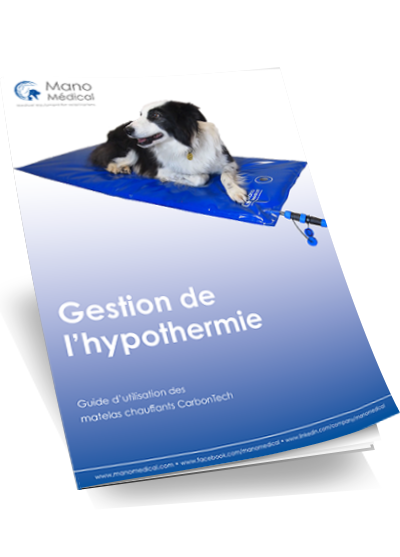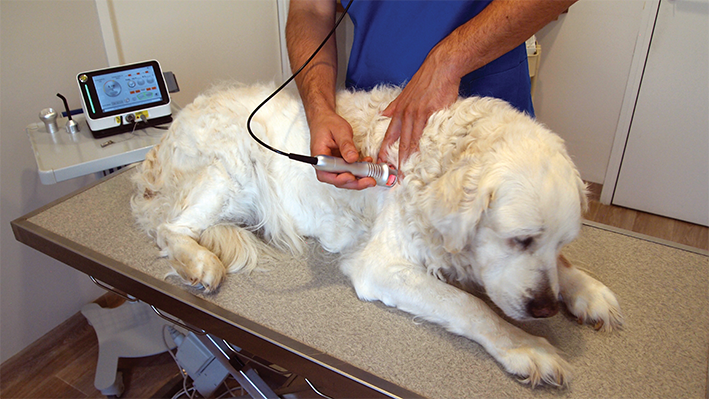Wavelengths:
- 640 nm
Superficial
Photo-coagulant
Anti-œdematous
- 810 nm
Deep
Production of ATP (energy, anti-inflammatory)
Regeneration of muscles and tendons
- 980 nm :
Deep
Production of ATP
Release of oxygen absorption
Analgesic
Optimal absorption of water and strong absorption by haemoglobin
Action on the peripheral nervous system (Gate Control type), e.g. Heat
General instructions for treatment set-up:
Clean hair: if possible, cut the fur/coat shorter. (50 to 90% of light can be absorbed by the hair)
Hair and skin colour are important factors as melanin absorbs the energy from short wavelengths.
Prior to treatment ensure all PPE is worn: Laser Glasses.
During a treatment ensure that your patient is positioned correctly and comfortably.
During the treatment continuously move the handpiece to cover a large area; whilst monitoring the temperature of the treatment area with your other hand.
- Techniques for the movement of the handpiece:
- Move from proximal to distal
- You can move the handpieces in a point to point movement. This treatment can take time. Therefore, most people apply the laser in a scanning motion.
- Techniques of applying the probe
- Contact: Using the massage ball applicator. Care must be taken on bony prominences or injured tissue as can cause pain.
- Non-contact: Using the non-contact applicator head.
You can hold the applicator head against the skin, but at no point does the laser beam directly come into contact with the tissue.
Download our guide
Biological effect: reduction of oedema and inflammation
- Action of Photo biomodulation (PBM) stimulation on pain Receptors
Laser light can regenerate damaged nerve endings. Laser light works by increasing nerve transmission, whilst also reducing the pain signal by means of blocking the pain pathway.
- Action of PBM on the transmission of pain impulses
Laser light slows down the conductivity of the pain pathway. Laser reduces the pain signal messages by reducing a synaptic substance called Substance P; Substance P is the main mediator in the transmission of a pain stimulus. stimulus) (Poitte, 2013).
- PBM and pain relief
Laser causes a significant increase in the level of endorphins in the blood and has a desirable effect on nerve fibres by suppressing neurons activated by a pain stimulus. It can be said that laser creates an opioid effect.
Peripheral nerve damage
Muscle tension
Traumatic pain
Post-operative pain
Spinal disease
Neuralgia
Muscle paralysis
Biological effect: reduction of oedema and inflammation
- Reduction in the number of polymorphonuclear cells. Reduction in cells associated with infections and allergic reactions. Laser reduces inflammation and stimulates phagocytic action and macrophages.
- Reduce concentrations of pro-inflammatory cytokines- reduce inflammation and promote healing (anti-inflammatory).
- Reduction of prostaglandins E2 level – by promoting relaxation of smooth muscle and constriction of blood vessels which results in modulation of inflammation.
- Increase lymphatic vessel function- by increasing microcirculation and dilation of the lymphatic vessels. This effect allows an anti-oedematous action whilst promoting the elimination of waste and acid residues.
Atopic dermatitis
Tendinitis, ligament disease
Otitis, rhinitis
Stomatitis
Sepsis
Chronic lymphoedema or post lymphoedema
Post thrombotic
Post traumatic oedema
Haematomas
Bruises
…
Biological effect on Tissue healing
- Inflammatory/detersive phase
This process is accelerated by the modulation of the inflammatory response. Laser light increases the phagocytic activity of the macrophages and the neutrophils increasing the articulation of growth factors.
- Proliferative phase
Laser light helps to form granulation tissue by increasing the activity of fibroblasts along with their collagen synthesis activity. It also improves local neo-angiogenesis, helping epithelisation through stimulation, growth and movement of keratinocytes. Whilst increasing the number of myofibroblasts helping contraction.
Post-operative
Ulcers- decubitus lesions
Burns
Ruptured muscle fibres
Tendon ruptures
Nerve damage (traumatic, inflammatory)
Cartilage disease and damage
Osteoarthritis
Fractures, bone disorders
Laser Therapy and physiotherapy: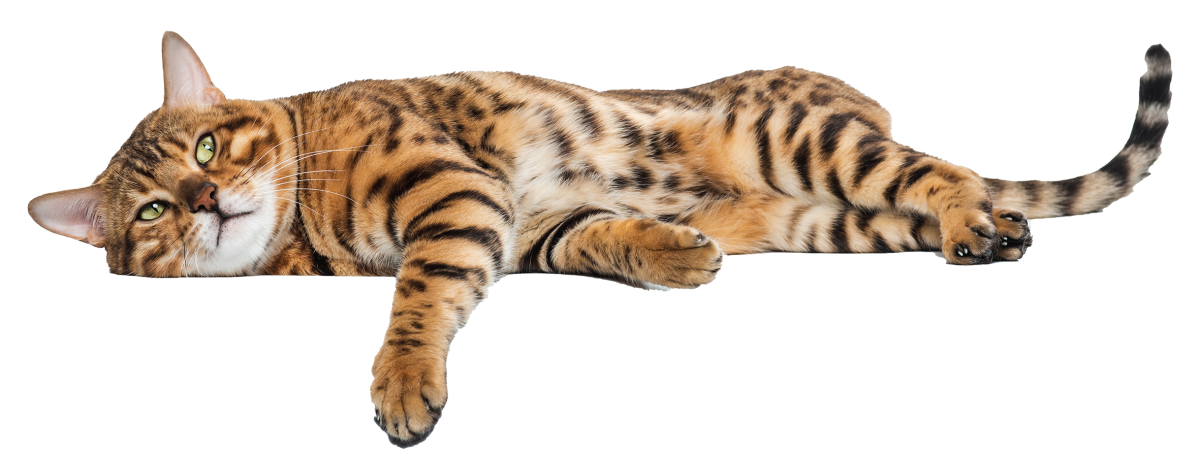
Laser therapy and physiotherapy complement each other well. It is recommended to carry out a laser treatment prior to a physiotherapy session.
The laser will heat and prepare the muscle for massage, relaxing the area to be treated and improving vascular supply.
Together laser and physiotherapy promote the removal of toxins and impurities from the tissue and muscle, thus resulting in a more effective treatment than using laser or physiotherapy alone, leading to higher success rates of treatment overall.
Choice of protocol:
- Depth reached
You need to know the wavelengths available on the laser in order to understand the depth of penetration.
630 to 740 nm: skin and acupuncture point
750 to 1500 nm: ligaments, intra-articular structure,… Penetration: factor difficult to assess with precision.
- Quantity of Joules delivered
The power (mW or W) must be known in order to determine the energy in J / s and the therapeutic dose. For example: a laser with P = 10 W delivers 20 J of energy for 2 continuous seconds. But in pulsed mode, 50% ON and 50% OFF, will give 10 J for 2 seconds.
 Your Mano Medical laser integrates all the necessary pre-recorded programs!
Your Mano Medical laser integrates all the necessary pre-recorded programs!
Treatment techniques: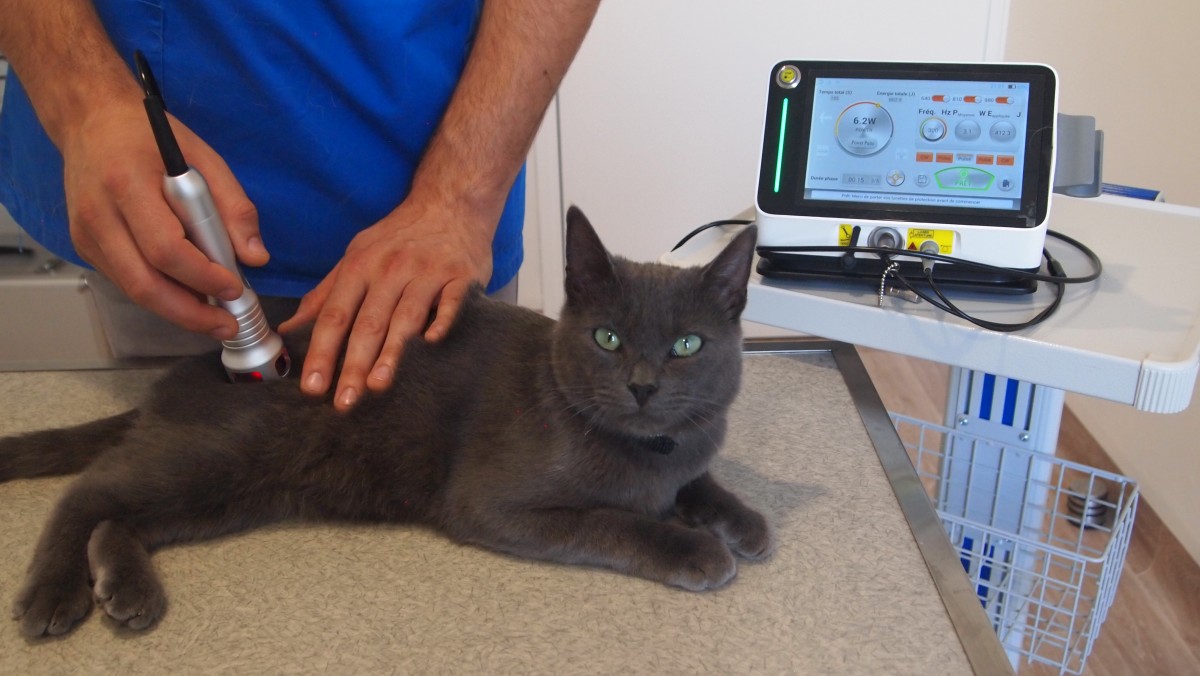
- Surgical wound
Immediately following a procedure.
Contraindicated following mass removal of
potential neoplastic tissue. As laser promotes cell proliferation.
- Surgical wound
Immediately after the procedure
Not after removal of mass which can be neoplastic because the laser promotes cell proliferation
Min 3 times / week - 7 to 10 days
- Licking granuloma
Source of the granuloma identified and treated
On the granuloma and at least 1 cm around
At the start every day
Until healing and hair regrowth
- Osteoarthritis
Accurate diagnosis necessary before treatment to be certain of the cause of the pain.
Movement analysis, pain scale, body score, ROM
- Hip
Fully treated joint
Start with the greater trochanter of the femur. Then cranial, medial and then caudal direction in a circumferential area
Often associated low back pain, so do not hesitate to treat the back
- Stifle
Start on the patella and move medially or laterally to treat around the joint.
Lateral cruciate ligaments can be treated from proximal to distal.
For muscular pain treat the tibia and fibula.
- Hock and digits
Start at the calcaneus bone. Take into account the anatomy of the hock and treat the whole area as well as the tendon.
Treat the digits and the dorsal and palmer aspects.
- Shoulder
Start at the level of the tubercle of the scapular spine and turn around the joint.
Sometimes bicep tendon is affected
Treat extra cervical and cervical muscles
- Carpus and digits
Start at the carpal bone. Treat the whole joint.
Treat the digits and the dorsal and palmer aspects.
Treat the radius and ulna as well.
- Cervical spine
Can be treated completely from the occipital process to the chest.
Treat the spinal muscles as well.
- Thoracic spine
Treat the area first by placing the laser on the vertebrae then treat adjacent areas (including muscles)
- Lumbar column
Same
- Post-surgery
Control of oedema
Faster healing
- Muscle, tendon, ligament, skin injury
Management and reduction of pain and inflammation
Improved healing
- Tear and elongation
Reduction of pain and inflammation.
Improved recovery
- Damage to the nervous system
Neuronal growth.
Pain management
- Osteoarthritis
Pain reduction
Reduction of inflammation
- Otitis
Helps to reduce inflammation in addition to conventional therapy
- Licking granuloma
Improves skin healing
Helps to stop irritation
Contraindications:
- Absolute considerations:
- Eye exposure – NEVER APPLY TO THE EYE AREA
- Special considerations:
- Locally injected medication
- Malignancy
- Pregnancy
- Precautions:
- Active epiphyses (Growing Animals)
- Haemorrhage
- Testicles
- Thyroid gland
- False contraindications:
- Hyperpigmentation and tattoos
- Implants
- Microbial infection
- Photosensitizing medication
How often and how long for which treatments?
| Osteoarthritis |
3 times the first week |
| Wounds and difficult healing | Once every 3 to 4 days then adapt the frequency according to the results until complete healing |
| Joint Pains | Once every 3 to 4 days then adapt the frequency according to pain intensity and effectiveness of the treatment |
| Gingival stomatitis | Once a day for 2 to 3 days then every 3 to 4 days |
| Post-surgical healing |
Once immediately after surgery |
| Other treatments | Generally speaking, any treatment of an acute problem will justify a higher frequency of treatments (several times / day if necessary) using lower powers. Conversely, the treatment of a chronic problem will be at higher power and lower frequency. |
Our support:
Take advantage of our training in small groups or remotely led by specialised veterinarians!
More information available on www.manomedical.com
Have a look at our training programme
Promotion of Laser Therapy in Your Clinic: 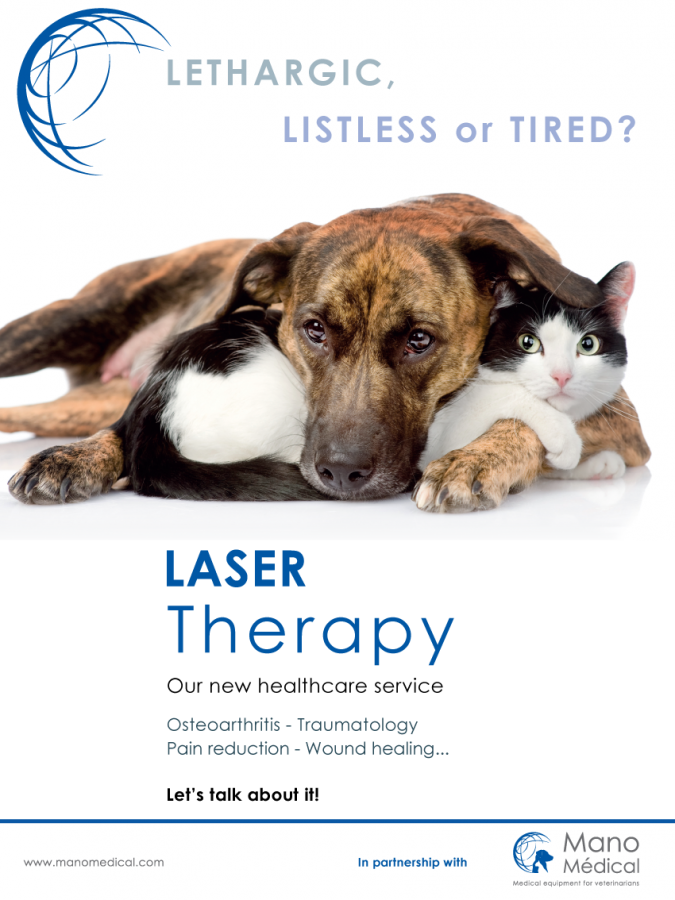
We offer to our vet clients equipped with our lasers, communication supports including posters and flyers.
(Available for our vet clients in France)



